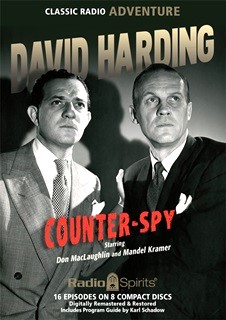
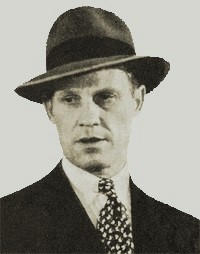 David Harding, Counter-Spy (1942-57) aired “The Case of the Washington Woman Spy” on June 8, 1942 as the 4th of its estimated 850 broadcasts, of which only approximately 75 still exist.
David Harding, Counter-Spy (1942-57) aired “The Case of the Washington Woman Spy” on June 8, 1942 as the 4th of its estimated 850 broadcasts, of which only approximately 75 still exist.
We showcased our first episode of this fine program in March of 2023, two years ago, and then another in September of that year. Our last offering came a year ago in March of 2024, so a brief recap of the show is in order. The creative genius behind Counter-Spy (retitled in 1946 to David Harding, Counter-Spy at the insistence of a new sponsor) was Phillips H. Lord (1902-1975, photo below left). Lord was highly respected in radio circles, having produced such popular programs as Gang Busters (1935-57), Mr. District Attorney (1939-53), and the patriotic series We, the People. When the United States entered world War II following the December 7, 1941 sneak attack on Pearl Harbor, Hawaii, Lord took notice that there were few true espionage programs on the air and decided to rectify the situation by creating Counter-Spy. Many of the stories were based on factual cases Lord had been given access to for use in his previous crime programs, but whose stories were of course dramatized, fictionalized accounts that proved popular with an anxious audience starved and ready for such Good Guys vs. Bad Guys espionage stories with the war at the forefront of their minds. Lord himself was no stranger to spy work, having been a confidential but official agent in secret counter intelligence work for four years before the war broke out.
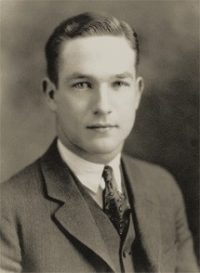
One aspect that brought the war closer to home was that Counter-Spy stories took place in, or close to the United States rather than abroad, with the first few years before the war ended devoted to tales with Lord’s fictional counter-spy, David Harding, and his assistant counter-spy Harry Peters (played by Mandel Kramer) dealing with Germany’s Gestapo and Japan’s Black Dragon spy agencies working clandestinely within the United States. Harding was special in that he was pretty much his own boss, with free-reign over what and how he handled sensitive cases while working with various government departments when his cases happened to cross into their individual jurisdictions. Don MacLaughlin (1906-86, photo top right) was cast as David Harding, his title being loosely interpreted as the head of the United States Counterspies Unit; one might legitimately say he was the Chief Counterspy of this “imaginary” unit. Like Lord, MacLaughlin was no newcomer to radio, having proved himself with his versatility in a number of prior action and dramatic productions. In truth, MacLaughlin had performed in, according to one source, “some 300 roles” since his radio debut in 1935. MacLaughlin secured the permanent role of Harding after the third episode, beating out some 20 others for the top spot. The Lord and MacLaughlin team turned out to be a match made in heaven, for MacLaughlin kept the role for the next 12 years. After the show ended in 1957, MacLaughlin began a new stage in his acting career as, for 30 years, he played attorney Chris Hughes on the daytime soap opera As the World Turns, until his death in 1986. Much interesting background could be added to this necessarily brief introduction to this one of a kind patriotic war time program, but suffice to say it became so popular so quickly that within a year it was so well-received that it took no summer hiatus, and for some of its future programming would be nominated for a Peabody Award and receive “numerous citations from local and civic groups throughout the 1940s.” Aside from a brief period of time (January 1949-August 1950) when it aired twice a week with Pepsi-Cola as the sponsor, David Harding, Counter-Spy was a weekly broadcast throughout its run.

One of the earliest episodes of this no-nonsense-minded spy show, “The Case of the Washington Woman Spy” is the story of how the female of the species was, and is to this day, used by governments in the role of spies, and quite effective ones at that. This particular scheme by which female spies can acquire the most sensitive information from the male of the species without said male being aware that he is being innocuously pumped for information has come to be known as the old “honeypot” trap. But to make an even more effective story out of this tried-and-true information gathering deception, the writer has offered the listener an additional turn to the tale, spicing up an already interesting story by adding another layer of fun to “The Case of the Washington Woman Spy.”
(The CD linked at top includes this episode and 15 others, all digitally remastered and restored, with a Program Guide by radio historian and friend to this weekly Golden Age of Radio feature, Karl Schadow.)
Play Time: 29:40
{Airing on a Monday evening in early June when the gang had just been paroled from the confines of schoolrooms and fenced playgrounds for a carefree summer, the neighborhood gang headed for the nearby newsstand the next morning to discover more thrills and adventure the likes of which they had experienced the night before in the latest David Harding, Counter-Spy episode. They were in luck with the following pulps in their sweaty hands as they headed for home. Crack Detective (1938-51), while a solid read and worth the dime the magazine asked, would end up known more for the 8 titles it went through during its decent run. As Crack Detective it was a bi-monthly in 1942 but managed only 5 issues. Detective Story Magazine (1915-1953) was the first pulp magazine in history to be devoted entirely to detective fiction. When the Nick Carter series of dime novels folded in the middle of a serial, Detective Story picked up the unpublished part without missing a beat and ran it in its first issue. The magazine ran for an astonishing 38 years, half of it as a weekly. It then gradually slowed down near the end of its run, and was a monthly in 1942. Weird Tales (1923-1954), while not a detective pulp, held other kinds of danger, thrills, and downright scary fare, soon being forever known as “the unique magazine.” Like a magnet, WT attracted the cream of the crop of those writers specializing in the supernatural, strange otherworldly journeys into places best not spoken of in the light of day, and surreal monsters that would keep certain youngsters of a more impressionable mind awake at night. Stories by Kuttner, Bloch, Lovecraft, Seabury Quinn, Clark Ashton Smith, August Derleth, Edmond Hamilton, Manly Wade Wellman, Fritz Leiber, C. L. Moore and many others would grace this classic pulps pages. It was a bi-monthly in 1942.}
[Left: Crack Detective, 5/42 – Center: Detective Story, 6/42 – Right: Weird Tales, 5/42]
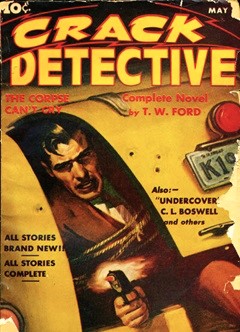
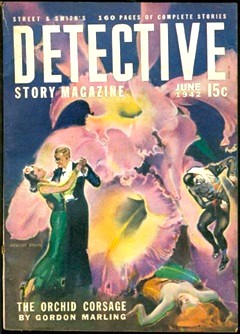
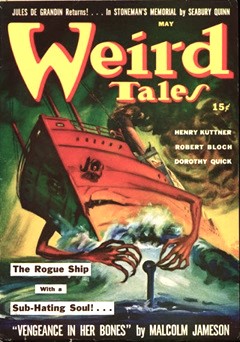
To view the entire list of weekly Old Time Radio episodes at Tangent Online, click here.